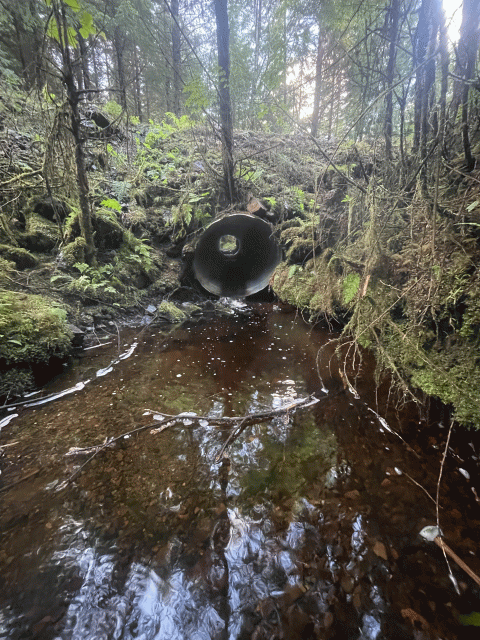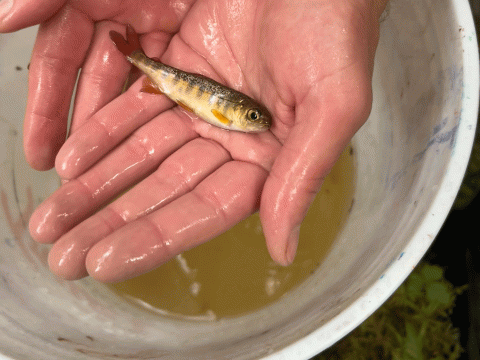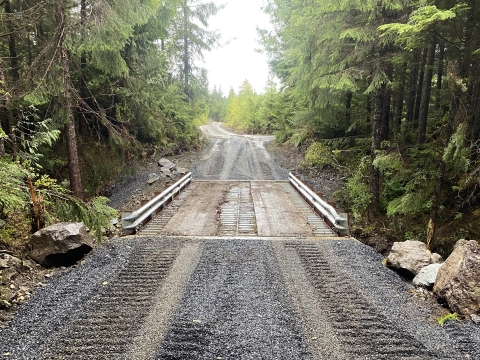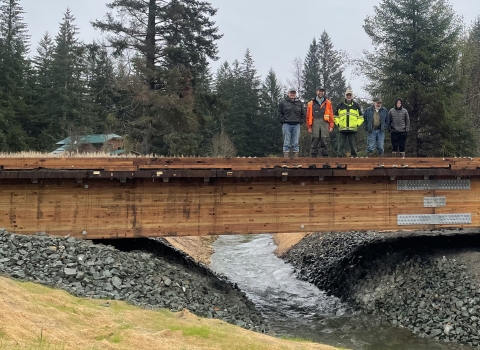In September 2024, the U.S. Fish and Wildlife Service, Sealaska Corporation, and Southeast Alaska Watershed Coalition completed the replacement of a fish passage fish passage
Fish passage is the ability of fish or other aquatic species to move freely throughout their life to find food, reproduce, and complete their natural migration cycles. Millions of barriers to fish passage across the country are fragmenting habitat and leading to species declines. The U.S. Fish and Wildlife Service's National Fish Passage Program is working to reconnect watersheds to benefit both wildlife and people.
Learn more about fish passage barrier with a fish-friendly bridge on Jon’s Creek.
The Setting
The headwaters of Jon’s Creek are steep and cold. From there, it quickly transitions into a flat, slow moving stream that zig zags around remnant old growth logs that fell into it long ago as it passes through a much younger, second growth forest. Before meeting the ocean near Klawock (Tlingit: Lawáak) on the west coast of Prince of Wales Island, it flows through small pockets of remnant uncut old growth forest where fish love the myriad overhanging structure structure
Something temporarily or permanently constructed, built, or placed; and constructed of natural or manufactured parts including, but not limited to, a building, shed, cabin, porch, bridge, walkway, stair steps, sign, landing, platform, dock, rack, fence, telecommunication device, antennae, fish cleaning table, satellite dish/mount, or well head.
Learn more about structure and pools.
Jon’s Creek is an important fish nursery. Its pools and undercut banks hide away juvenile Coho Salmon that move in from the adjacent mainstem system, Steelhead Trout and Dolly Varden Char. Adult Pink Salmon spawn in Jon’s Creek proper and Coho Salmon may spawn in its lower reaches as well.
The Problems
Jon’s creek previously had to tumble through an undersized metal culvert midway up its course that carried it through Big Salt Road. The size and placement of this culvert made Jon’s Creek waterfall into a pool below, creating a small jump barrier for baby salmonids wanting to go upstream. In addition to being fragmented at the road, the creek also lacks the instream wood in some sections—instream wood that makes it so attractive to fish. This is due to prior human removals and a younger surrounding forest that isn’t yet contributing new, large wood. And we know how much fish love trees!
The Fix
To fix these problems, the team worked with Southeast Road Builders to remove the too-small culvert, construct a new stream channel through the crossing, and install a bridge to carry the road over the stream. The project utilized a bridge already owned by Sealaska that was shipped from Hoonah and retrofitted for this crossing using a design by the Menzies Engineering Group with input from the U.S. Fish and Wildlife Service’s Alaska engineering design team.
A goal of the project was to reconstruct the stream in a way that mimics the natural channel. This technique, called stream simulation, helps maximize fish passage, improves wildlife crossing potential, promotes natural sediment transport, and allows for improved passage of downed trees which create habitat for fish. This approach focuses on keeping the stream seamless through the crossing, including its natural channel shape and slope. Because the old culvert had been set at the wrong gradient, the team had to dig the channel down to tie it into the natural slope extending above and below the crossing. Not only is the channel back to its natural slope, but there are now natural banks on either side of the creek underneath the new bridge.
The bridge construction project was completed quickly just in time for dozens of adult pink salmon to be the first customers to swim under the new road-stream crossing.
The Larger Partnership at Work
This project began as part of a partnership between the U.S. Fish and Wildlife Service and Sealaska to improve fish passage on their lands in Southeast Alaska with funding support from NOAA. In addition to fixing this culvert, Sealaska worked with SAWC and the Klawock Indigenous Stewards Forest Partnership (KISFP) to improve fish habitat in Jon’s Creek below the crossing. This 2023 effort involved a hand tool restoration project where SAWC and KISFP installed large woody habitat structures in the stream to improve fish habitat. In a watershed that was logged, this project helped jump start the availability of wood in the stream for fish habitat while the trees along the banks are still maturing. The KISFP crew intends to do a similar hand tool restoration project upstream of the new bridge next summer to further improve fish habitat in this stream. This project is one of several projects funded with Bipartisan Infrastructure Law Bipartisan Infrastructure Law
The Bipartisan Infrastructure Law (BIL) is a once-in-a-generation investment in the nation’s infrastructure and economic competitiveness. We were directly appropriated $455 million over five years in BIL funds for programs related to the President’s America the Beautiful initiative.
Learn more about Bipartisan Infrastructure Law funding to be completed in Alaska in 2024.
We hope to continue working with these great partners to improve fish passage, watershed and stream health across Alaska.
Learn more & Listen:
Culvert Design Guidelines for Ecological Function
Called to Sea: Steelhead Answer
The Quiet Love Affair Between Fish and Trees
We honor, thank, and celebrate the whole community—individuals, Tribes, the State of Alaska, sister agencies, fish enthusiasts, scientists, and others—who have elevated our understanding and love, as people and professionals, of all the fish. In Alaska we are shared stewards of world renowned natural resources and our nation’s last true wild places. Our hope is that each generation has the opportunity to live with, live from, discover and enjoy the wildness of this awe-inspiring land and the people who love and depend on it.
Follow us: Facebook Instagram
Catch new Fish of the Week! episodes every Monday













